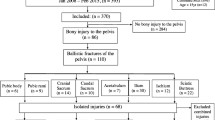Abstract
The aim of this study is to determine the incidence and location of Morel-Lavallee lesions (MLLs) on pelvic CTs performed in evaluation of pelvic fractures and determine if correlation exists between MLLs and mechanism of injury or pelvic ring injury pattern. A retrospective review was performed of pelvic CTs on 1493 consecutive patients presenting with pelvic fractures at our level 1 trauma center. MLLs occurred in 182 of 1493 patients presenting with pelvic fractures. Statistical significance in MLL incidence was found across mechanism of injuries with MLLs being seen most frequently in MCC/ATV accidents and crush injuries. A little over half of MLLs occurred over the lateral thigh with almost all other MLLs occurring over the posterior (flank or lumbar) region. MLLs were much more common in vertical shear and spinopelvic dissociation pelvic ring fracture patterns compared to lateral compression and AP compression patterns. In lateral compression injuries, MLLs most commonly occurred over the thigh. In all other pelvic ring injury patterns, MLLs were predominately posterior. MLL’s are not as rare as previously believed. The lateral thigh and lumbar/flank regions should be closely inspected on pelvic trauma patients to identify MLLs, particularly in patients with a spinopelvic dissociation injury pattern.


Similar content being viewed by others
References
Tejwani SG, Cohen SB, Bradley JP (2007) Management of Morel-Lavallee lesion of the knee: twenty-seven cases in the National Football League. Am J Sports Med 35(7):1162–1167
Vanhegan IS, Dala-Ali B, Verhelst I, Mallucci P, Haddad FS (2012) Diagnosis for recalcitrant bursitis of the knee: case report and literature review. Case Reports Orthop 2012:593193
Bansal A, Bhatia N, Singh A, Singh AK (2013) Doxycycline sclerodesis as a treatment option for persistent Morel-Lavallee lesions. Injury 44(1):66–69
McKenzie GA, Niederhauser BD, Collins MS, Howe BM (2016) CT characteristic of Morel-Lavallee lesions: an under-recognized but significant finding in acute trauma imaging. Skeletal Radiol
Nickerson TP, Zielinski MD, Jenkins DH, Schiller HJ (2014) The Mayo Clinic experience with Morel-Lavallee lesions: establishment of a practice management guideline. J Trauma Acute Care Surg 76(2):493–497
Palacio EP, Di Stasi GG, Lima EH, Mizobuchi RR, Junior AD, Galbiatti JA (2015) Results from surgical treatment of Morel-Lavallee lesions: prospective cohort study. Rev Bras Ortop 50(2):148–152
Shen C, Peng JP, Chen XD (2013) Efficacy of treatment in peri-pelvic Morel-Lavallee lesion: a systematic review of the literature. Arch Orthop Trauma Surg 133:635–640
Khodaee M, Deu RS (2016) Ankle Morel-Lavallee lesion in a recreational racquetball player. J Sports Med Phys Fitness
Garner A, Beard D, Ostlere S, Price A, Rout R (2014) Morel-Lavallee lesions of the knee: a closed degloving injury: a report of two cases. ANZ J Surg 84(10):789–791
Zecha PJ, Missotten FE (1999) Pseudocyst formation after abdominoplasty – extravasations of Morel-Lavallee. Br J Plast Surg 52(6):500–502
Tseng S, Tornetta P (2006) Percutaneous management of Morel-Lavallee lesions. J Bone Joint Surg Am 88(1):92–96
Letournel E (1993) Operative treatment of specific types of fracture: posterior wall fractures. In: Letournel E, Judet R (eds) Elson, RA (translating editor). Fractures of the acetabulum, 2nd edn. Springer, Berlin, pp. 417–521
Hudson DA, Knottenbelt JD, Krige JE (1992) Closed degloving injuries: results following conservative surgery. Plast Reconstr Surg 89(5):853–855
Tsur A, Galin A, Kogan L, Loberant N (2006) Morel-Lavallee syndrome after crush injury. Harefuah 145(2):111–113
Hak DJ, Olson SA, Matta JM (1997) Diagnosis and management of closed internal degloving injuries associated with pelvic and acetabular fractures: the Morel-Lavallee lesion. J Trauma 42(6):1046–1051
Li Q, Liu P, Wang G, Yang Y, Dong J, Wang Y, Zhou D (2015) Risk factors of surgical site infection after acetabular fracture surgery. Surg Infect 16(5):577–582
Dodwad SN, Niedermeier SR, Yu E, Ferguson TA, Klineberg EO, Khan SN (2013) The Morel-Lavallee lesion revisited: management in spinopelvic dissociation. Spine Jour 15:e1–e7
Carlson DA, Simmons J, Sando W, Weber T, Clements B (2007) Morel-Lavallee lesions treatd with debridement and meticulous dead space closure: surgical technique. J Ortho Trauma 21(2):140–144
Burgess AR, Eastridge BJ, Young JW, Ellison TS, Ellison PS Jr, Poka A, Bathon GH, Brumback RJ (1990) Pelvic ring disruptions: effective classification system and treatment protocols. J Trauma 30(7):848–856
Hudson DA (1996) Missed closed degloving injuries: late presentation as a contour deformity. Plast Reconstr Surg 98(2):334–337
Zhong B, Zhang C, Luo C (2014) Percutaneous drainage of Morel-Lavallee lesions when the diagnosis is delayed. Can J Surg 57(5):356–357
Steiner CL, Trentz O, Labler L (2008) Management of Morel-Lavallee lesion associated with pelvic and/or acetabular fractures. Eur J Trauma Emerg Surg 34(6):554–560
Luria S, Yaakov A, Yoram W, Meir L, Peyser A (2006) Talc sclerodhesis of persistent Morel-Lavallee lesions (posttraumatic pseudocyst): case report of 4 patients. J Orthop Trauma 20(6):435–438
Greenhill D, Haydel C, Rehman S (2016) Management of the Morel-Lavallee lesion. Orthop Clin North Am 47(1):115–125
Acknowledgments
We would like to thank the Memorial Hospital System in Houston. We acknowledge the support provided by the Biostatistics/Epidemiology/Research Design (BERD) component of the Center for Clinical and Translational Sciences (CCTS) for this project. CCTS is mainly funded by a grant (UL1 TR000371) from the National Center for Advancing Translational Sciences (NCATS), awarded to University of Texas Health Science Center at Houston. The content is solely the responsibility of the authors and does not necessarily represent the official views of the NCATS.
Author information
Authors and Affiliations
Corresponding author
Ethics declarations
Conflict of interest
The authors declare that they have no conflict of interest.
Rights and permissions
About this article
Cite this article
Beckmann, N.M., Cai, C. CT incidence of Morel-Lavallee lesions in patients with pelvic fractures: a 4-year experience at a level 1 trauma center. Emerg Radiol 23, 615–621 (2016). https://doi.org/10.1007/s10140-016-1430-1
Received:
Accepted:
Published:
Issue Date:
DOI: https://doi.org/10.1007/s10140-016-1430-1




